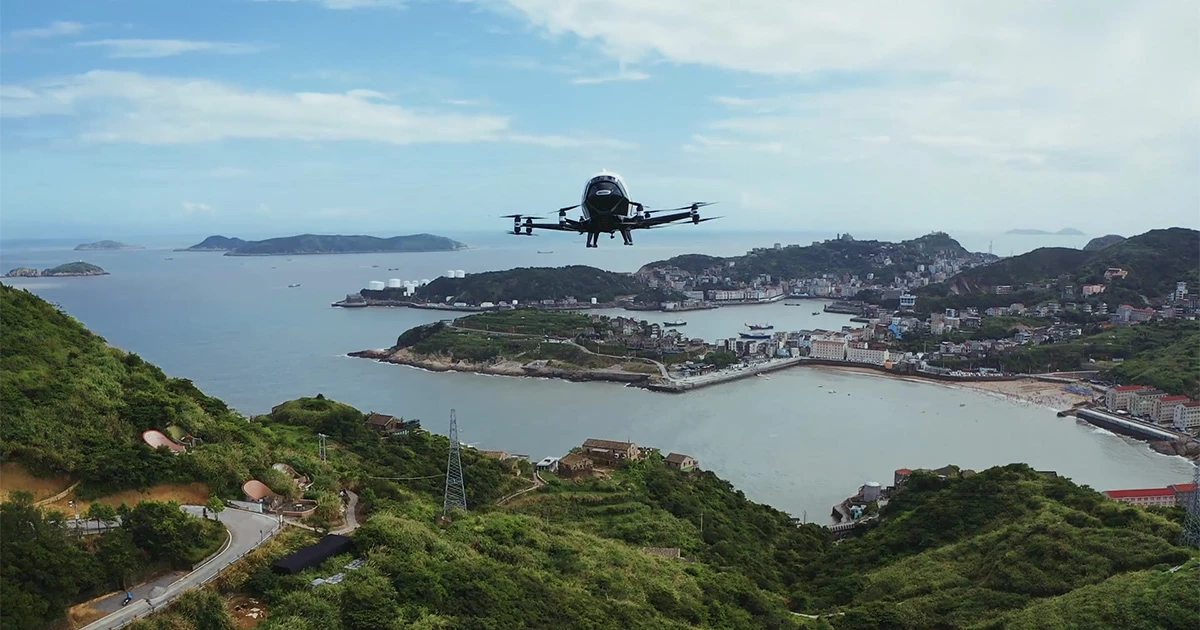China's eHang says it's "hopeful" it'll achieve full type certification for its autonomous EH216 eVTOL aircraft "in the next few months," after which commercial operations can begin – potentially years earlier than American and European competitors.
eHang's executive team gave several insights into the company's progress as part of its Q3 2021 earnings call. "EHang and the CAAC (Civil Aviation Administration of China) have reached a consensus," remarked Founder, Chairman and CEO Huazhi Hu, "on the guiding principle that operational trial flights can gradually be carried out, while advancing the certification progress."
That appears to explain how eHang has been running so many manned flights prior to full certification, where American and European eVTOL companies are continuing with unmanned testing, working under stricter legislation. The company says it's already completed around 2,800 "operational trial flights" across seven "air mobility trial operations" providing aerial sightseeing and short-distance mobility services in Guangzhou, Hezhou, Shenzen, Zhaoqing and Sanya.
This is in addition to more than 20,000 autonomous trial flights the EH216 had taken in 11 different countries – far more, the company claims, than any other manufacturer. "With abundant operational experience accumulated and safety records built," reads the earnings report, "the Company expects to turn these operational trial flights into commercial ones after the approval of the EHang 216 Type Certificate is obtained."

"On the certification of our EHang 216 AAV, we have attached paramount emphasis on this project and have been promoting our cooperation with CAAC," said Chief Strategy Officer Edward Huaxiang Xu. "After multi rounds of discussion with CAAC expert team, our certification work has entered into the final stages of verification. So far the work progress appears to be satisfying, so we remain hopeful to obtain CAAC's approval on EHang 216 type certification in the next few months."
Meanwhile, the USA's leading company Joby Aviation is hoping to become the first FAA-certified eVTOL sometime in 2023. Germany's Lilium doesn't expect to have its machines ready for commercial rollout until 2024.
What's more, China is also giving eHang another huge advantage over the rest of the field, since its aircraft will launch as autonomous air vehicles. The rest of the world expects air taxis to debut with pilots on board, eventually moving toward autonomous operation several years down the track, but eHang is already running pilotless operations and integrating eVTOLs in with helicopter services and local air traffic considerations. The ability to free up a seat will be huge in this kind of vehicle, saving operators a ton of money while delivering extra revenue per flight.
We've spent some time in the past exploring how the eVTOL market is seen as more than just a commercial battle between China and America; the US military is directing a firehose of money at several eVTOL companies in the name of national security through the USAF's Agility Prime program. But if this really is another space race, it looks like it's just about over. China may win by a mile, thanks to the red tape it's willing to cut and the "innovation mindset" the CAAC is adopting.

As for eHang's long-range lift-and-cruise-style VT30 aircraft, Hu says it's "already capable of flying" and preparing for a flight demo "in due course." The VT30 is capable of flying 300 km (186 miles) thanks to its ability to transition to efficient winged flight. It's also likely to be significantly faster than the EH216, which can only manage around 130 km/h (80 mph) and ranges up to 35 km (22 miles), since it's basically just a scaled-up multicopter.
So it seems quite possible that commercial, pilotless eVTOL air taxi operations will be up and running in China by mid-2022 – possibly more than five years ahead of anywhere else. It also seems that the CAAC's "innovation mindset" towards manned flights hasn't resulted in any incidents at this stage, although we're not sure we'd put a lot of faith in state-owned media allowing the news to get out if anything did happen.
Either way, it seems we'll start to learn how these air taxis fit in with urban life sooner rather than later, and that's going to be something the whole world can learn from. Check out one of eHang's autonomous passenger flight trials in the video below.








